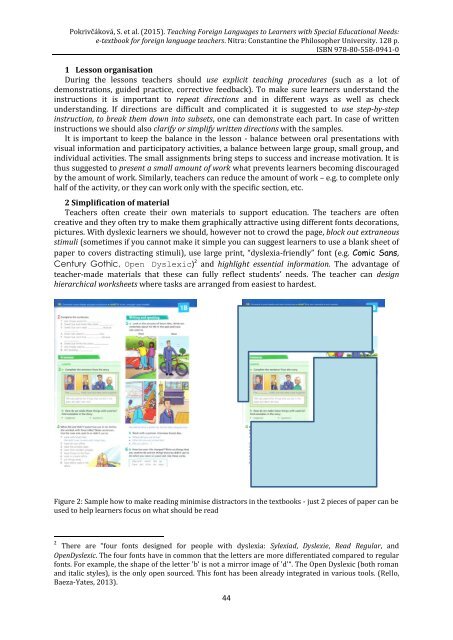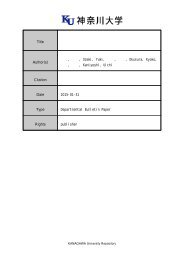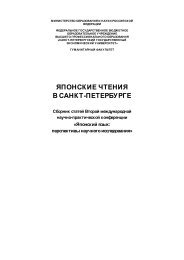to Learners with Special Educational Needs
e-textbook SEN
e-textbook SEN
You also want an ePaper? Increase the reach of your titles
YUMPU automatically turns print PDFs into web optimized ePapers that Google loves.
Pokrivčáková, S. et al. (2015). Teaching Foreign Languages <strong>to</strong> <strong>Learners</strong> <strong>with</strong> <strong>Special</strong> <strong>Educational</strong> <strong>Needs</strong>:<br />
e-textbook for foreign language teachers. Nitra: Constantine the Philosopher University. 128 p.<br />
ISBN 978-80-558-0941-0<br />
1 Lesson organisation<br />
During the lessons teachers should use explicit teaching procedures (such as a lot of<br />
demonstrations, guided practice, corrective feedback). To make sure learners understand the<br />
instructions it is important <strong>to</strong> repeat directions and in different ways as well as check<br />
understanding. If directions are difficult and complicated it is suggested <strong>to</strong> use step-by-step<br />
instruction, <strong>to</strong> break them down in<strong>to</strong> subsets, one can demonstrate each part. In case of written<br />
instructions we should also clarify or simplify written directions <strong>with</strong> the samples.<br />
It is important <strong>to</strong> keep the balance in the lesson - balance between oral presentations <strong>with</strong><br />
visual information and participa<strong>to</strong>ry activities, a balance between large group, small group, and<br />
individual activities. The small assignments bring steps <strong>to</strong> success and increase motivation. It is<br />
thus suggested <strong>to</strong> present a small amount of work what prevents learners becoming discouraged<br />
by the amount of work. Similarly, teachers can reduce the amount of work – e.g. <strong>to</strong> complete only<br />
half of the activity, or they can work only <strong>with</strong> the specific section, etc.<br />
2 Simplification of material<br />
Teachers often create their own materials <strong>to</strong> support education. The teachers are often<br />
creative and they often try <strong>to</strong> make them graphically attractive using different fonts decorations,<br />
pictures. With dyslexic learners we should, however not <strong>to</strong> crowd the page, block out extraneous<br />
stimuli (sometimes if you cannot make it simple you can suggest learners <strong>to</strong> use a blank sheet of<br />
paper <strong>to</strong> covers distracting stimuli), use large print, “dyslexia-friendly” font (e.g. Comic Sans,<br />
Century Gothic, Open Dyslexic) 2 and highlight essential information. The advantage of<br />
teacher-made materials that these can fully reflect students’ needs. The teacher can design<br />
hierarchical worksheets where tasks are arranged from easiest <strong>to</strong> hardest.<br />
Figure 2: Sample how <strong>to</strong> make reading minimise distrac<strong>to</strong>rs in the textbooks - just 2 pieces of paper can be<br />
used <strong>to</strong> help learners focus on what should be read<br />
2 There are “four fonts designed for people <strong>with</strong> dyslexia: Sylexiad, Dyslexie, Read Regular, and<br />
OpenDyslexic. The four fonts have in common that the letters are more differentiated compared <strong>to</strong> regular<br />
fonts. For example, the shape of the letter 'b' is not a mirror image of 'd'“. The Open Dyslexic (both roman<br />
and italic styles), is the only open sourced. This font has been already integrated in various <strong>to</strong>ols. (Rello,<br />
Baeza-Yates, 2013).<br />
44






